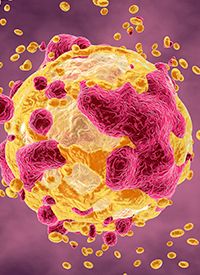Article
Relma-cel Demonstrates Durable Activity in Relapsed/Refractory LBCL
Author(s):
Relmacabtagene autoleucel elicited durable responses and a high overall survival rate in Chinese patients with relapsed/refractory large B-cell lymphoma, according to 2-year follow-up data from the phase 2 RELIANCE trial.

Relmacabtagene autoleucel (relma-cel; Carteyva) elicited durable responses and a high overall survival (OS) rate in Chinese patients with relapsed/refractory large B-cell lymphoma (LBCL), according to 2-year follow-up data from the phase 2 RELIANCE trial (NCT04089215) presented during the 2022 ASCO Annual Meeting.1
At a median follow-up of 24 months (95% CI, 23.9-24.1) , the best overall response rate (ORR) achieved with the autologous CD19-targeted CAR T-cell therapy was 77.6% among 58 evaluable patients, which included a complete response (CR) rate of 53.5%. The median duration of response (DOR) was 20.3 months (95% CI, 4.86–not estimable [NE]), and the 2-year DOR rate was 40.3%.
Moreover, the median progression-free survival (PFS) with the therapy was 7 months (95% CI, 4.76-24.15), and the median OS was not yet reached. The 2-year PFS and OS rates were 38.8% and 69.3%, respectively.
“Relma-cel demonstrated durable responses with a high 2-year overall survival [OS] rate,” lead study author Zhitao Yang, MD, of the Department of Lymphoma and Key Laboratory of Carcinogenesis and Translational Research (Ministry of Education) of Peking University Cancer Hospital & Institute in Beijing, China, and colleagues, wrote in a poster presentation of the data. “The median OS has not yet been reached for responding patients, and [there was] a manageable safety profile.”
RELIANCE was the first study of a CD19-directed CAR T-cell therapy to receive investigational new drug approval by the China National Medical Products Administration. Prior results from the study showed high response rates and low toxicity with relma-cel.
The study enrolled patients who were 18 years or older with histologically LBCL who received at least 2 prior lines of therapy. Patients were required to have an ECOG performance status of 0 or 1, an accessible PET-positive lesion, a measurable CT-positive lesion, adequate organ function, and acceptable vascular access for leukapheresis.2 Those who received prior CD19-targeted therapy needed to confirm that their lesions still expressed CD19.
Key exclusion criteria included central nervous system (CNS)–only involvement, a history of another primary malignancy that has not been in remission for at least 2 years, or any history of a serious cardiovascular disease, among others.
Fifty-nine adult patients were randomized to receive relma-cel at 100 x 106 CAR-positive T cells or 150 x 106 CAR-positive T cells. Prior to CAR T-cell infusion, all patients received lymphodepleting chemotherapy, and some received bridging chemotherapy.
The primary end point of the study was 3-month ORR. Secondary end points included 3-month CR rate, DOR, PFS, OS, and safety.
Additional data showed that among evaluable patients who received relma-cel at 100 x 106 CAR-positive T cells (n = 21), the median DOR was 23.3 months (95% CI, 5.16-NE). Those who were administered the therapy at 150 x 106 CAR-positive T cells (n = 24), experienced a median DOR of 6.0 months (95% CI, 2.99-NE).
In patients who received relma-cel at 100 x 106 CAR-positive T cells (n = 27), the median PFS was 8.8 months (95% CI, 5.55-NE). For those who received the therapy at 150 x 106 CAR-positive T cells (n = 31), the median PFS was 5.5 months (95% CI, 2.96-21.19).
Regarding safety, 91.5% of patients experienced at least 1 treatment-related adverse effect (TRAE) with relma-cel, and 55.9% had at least 1 effect that was grade 3 or higher in severity. Any-grade cytokine release syndrome (CRS) and neurotoxicity occurred in 47.5% and 20.3% of patients, respectively; these effects were grade 3 or higher in 5.1% and 3.4% of patients, respectively.
The median duration of any-grade CRS was 7 days (range, 1-118), and the median time to CRS was 4 days (range, 1-10). The median duration of any-grade neurotoxicity was 12.5 days (range, 1-49), and the median duration of neurotoxicity was 8.5 days (range, 2-11).
The other most common grade 3 or higher TRAEs included neutropenia (40.7%), leukopenia (22%), lymphopenia (11.9%), thrombocytopenia (11.9%).
Although relma-cel has shown to have manageable safety and to produce substantial durable responses in this population, further follow up is needed, according to the study authors.
References
- Ying Z, Song Y, Yang H, et al. Two-year follow-up result of RELIANCE study, a multicenter phase 2 trial of relmacabtagene autoleucel in Chinese patients with relapsed/refractory large B-cell lymphoma. J Clin Oncol. 2022;40(suppl 16):7529. doi:10.1200/JCO.2022.40.16_suppl.7529
- CD19-targeted CAR T cells for relapsed and refractory (R/R) non-Hodgkins lymphoma. ClinicalTrials.gov. Updated January 22, 2021. Accessed August 17, 2022. https://clinicaltrials.gov/ct2/show/NCT04089215









